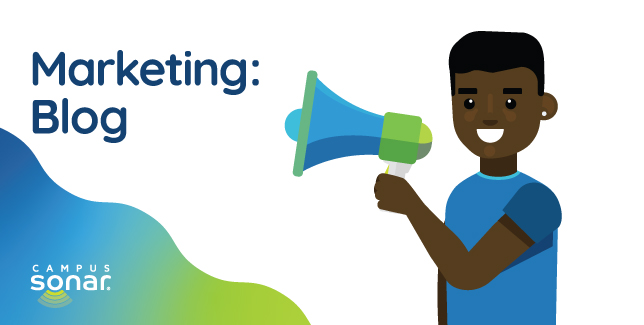Using segments such as program and degree type should empower you to analyze your online conversation against a comparable sample, rather than the industry as a whole.
by Amber Sandall, Campus Sonar Director of Client Services

Social listening can be a highly valuable tool for any campus looking to better understand their organization and the online conversation that surrounds them. That said, it can be easy to make generalizations about your own campus based on assumptions from the entire industry. In reality, the variation between campuses can be night and day, and the ability to segment annual data based on unique institutional characteristics can help you better understand the trends happening across the industry and among peers with similar characteristics.
We analyzed non-athletic annual conversation across three main segments: Program Type, Enrollment Size, and Institution Type. These segments should empower you to analyze your campus’s online conversation against a comparable sample, rather than the industry as a whole. Once you determine how your campus aligns with comparable institutions, use that information to inform and adjust your marketing and outreach efforts. If you’re at the high end, try to uncover what factors drive your conversation volume up, and lean into those strengths. If you’re at the low end, consider what opportunities exist to build out additional content and engage with your priority audiences.
Trends Across the Sample
There’s a distinct relationship between total annual conversation volume and the total number of unique online authors contributing to their conversation. That is, the more unique authors an institution can attract, the greater their online conversation volume. While this may appear obvious, it underscores an important lesson: campuses with larger online conversation volume get more people to talk about them rather than getting their existing audience to talk about them more.
The average value for total mentions per unique author stayed relatively consistent for each program and degree type, falling between 2 and 4. Campuses focused on Health and Master’s degree programs had a greater ratio of mentions per unique author compared to other program types.
Among all program types social media contributed the greatest volume toward total online conversation, followed by news sources, and then blogs or forums depending on slight variation in the program type categories. This is expected because Twitter is our largest online data source for social listening.
The program types that are primarily degree-conferring institutions (e.g., Bachelor’s, Master’s, and Doctoral), had the greatest proportion of social media mentions. These institutions tend to have an on-campus athletic presence, which can be a significant driver of online social media conversation, and are also likely to staff and support a robust social media marketing presence.
Health-related institutions had the greatest earned presence on online forums, at nearly 11% of total volume, followed closely only by Doctoral institutions at 7%. Medical school admissions is a common topic on online forums and there are numerous independent online forum sites dedicated to that topic alone, which may have contributed to the high degree of forum use in that program type.
Note that due to changes in our social listening software, the number of mentions classified as positive or negative in sentiment increased compared to the previous report. This is a factor in the increase of positive and negative mention proportions since the previous report.
Degree Type
We analyzed the key differences in online conversation between institutional program type, excluding all conversation related to athletics, to identify trends and differences for these distinct segments. Failing to make these distinctions could cause you to make incorrect assumptions about your campus based on irrelevant data. We placed each institution in our dataset into one of seven categories based on Carnegie Classification of Institutions of Higher Education® (CCIHE) program type. The seven categories include the following.
Program Type |
Carnegie Classification |
Institutions in Sample |
Median Conversation Volume |
Middle 50% for Non-athletic Annual Conversation |
| Bachelor's | Arts & Sciences, Diverse, Mixed BA/AA | 25 | 3,088 | 1,516–6,841 |
| Master's | Master's | 23 | 5,576 | 3,226–12,785 |
| Doctoral | Doctoral | 14 | 56,557 | 22,512–170,390 |
Bachelor's |
Master's |
Doctoral |
|
| Median Annual Conversation Volume | 12,342 | 19,231 | 140,281 |
| Typical Range Annual Conversation Volume | 2,664–21,985 | 10,263–46,894 | 60,346–318,384 |
| Average % Owned Conversation Volume | 37% | 40% | 30% |
| Average % Earned Conversation Volume | 63% | 60% | 70% |
| Average Positive Sentiment Breakdown | 26% | 28% | 23% |
| Average Neutral Sentiment Breakdown | 66% | 66% | 69% |
| Average Negative Sentiment Breakdown | 8% | 6% | 8% |
| Median Volume of Annual Authors | 3,391 | 4,575 | 43,482 |
| Typical Range of Annual Authors | 927–5,628 | 2,725–12,857 | 15,605–83,733 |
| Average % Social Media Conversation | 80% | 78% | 70% |
| Average % News Conversation | 14% | 17% | 21% |
| Average % Blogs Conversation | 4% | 4% | 4% |
| Average % Forums Conversation | 2% | 1.5% | 6% |
Bachelor’s
The Carnegie Classification® for Bachelor’s generally includes institutions where baccalaureate or higher degrees represent about 50% of all degrees but where fewer than 50 master’s degrees or 20 doctoral degrees were awarded annually.
Most metrics for bachelor’s institutions increased compared to our previous analysis.
- On average, bachelor’s institutions generated more owned content by 10 percentage points.
- Positive sentiment, on average, increased year over year by 10 percentage points. At the same time, negative sentiment increased by 6 percentage points.
Master’s
The Carnegie Classification® for Master’s generally includes institutions that awarded at least 50 master’s degrees and fewer than 20 doctoral degrees annually.
Note that some changes we indicate below may be due to our adjusted sample.
- On average, master’s institutions generated more owned content by 14 percentage points.
- Primarily master’s degree institutions can expect about 2 annual mentions per unique author.
- Primarily Master’s degree institutions can expect about 4 mentions per unique author per year.
Doctoral
The Carnegie Classification® for Doctoral generally includes institutions that awarded at least 20 research/scholarship doctoral degrees annually with below 20 research/scholarship doctoral degrees that awarded at least 30 professional practice doctoral degrees in at least two programs.
- Doctoral institutions had the greatest range of total conversation volume across institutions by degree type due to a few key outliers sample with large Division I athletic programs that dominated online conversation.
- On average, doctoral institutions generated more owned content by 15 percentage points.
- Primarily Doctoral degree institutions can expect about three annual mentions per unique author.
Program Type
Analyzing key differences in online conversation between program type, excluding all conversation related to athletics, identifies key trends and differences for these distinct segments. Failing to make these distinctions could cause you to make incorrect assumptions about your campus based on inapplicable data. We placed each institution into one of seven categories based on Carnegie Classification of Institutions of Higher Education® (CCIHE) program type. The seven categories include the following.
Program Type |
Carnegie Classification |
Institutions in Sample |
Median Conversation Volume |
Middle 50% for Non-athletic Annual Conversation |
| Art, Music, and Design | Art, Music, and Design | 4 | 806 | 607–1,608 |
| Faith | Faith | 9 | 1,178 | 522–1,585 |
| Health | Health | 11 | 1,962 | 224–2,284 |
Art, Music, Design |
Faith |
Health |
|
| Median Annual Conversation Volume | 806 | 1,585 | 1,962 |
| Typical Range Annual Conversation Volume | 607–1,608 | 1,178–3,795 | 224–2,285 |
| Average % Owned Conversation Volume | 14% | 35% | 33% |
| Average % Earned Conversation Volume | 86% | 65% | 70% |
| Average Positive Sentiment Breakdown | 16% | 30% | 19% |
| Average Neutral Sentiment Breakdown | 83% | 63% | 72% |
| Average Negative Sentiment Breakdown | 2% | 7% | 8% |
| Median Volume of Annual Authors | 227 | 463 | 245 |
| Typical Range of Annual Authors | 202–703 | 301–919 | 57–673 |
| Average % Social Media Conversation | 47% | 79% | 62% |
| Average % News Conversation | 33% | 14% | 23% |
| Average % Blogs Conversation | 19% | 7% | 10% |
| Average % Forums Conversation | 1% | 0.8% | 11% |
Arts, Music, and Design
- The median annual conversation volume for Arts, Music, and Design schools fell by 56% compared to our previous analysis.
- On average, owned conversation fell by 2 percentage points.
- For the 2018–2019 analysis period, the number of unique authors ranged from 143 to 231, plus one outlier of over 2,000 unique authors.
- The most significant change since the past report is a 6 percentage point decrease in social media conversation, proportional to an increase in news and blog content.
- Campuses in this category should not expect more than a few hundred unique online authors. Based on average volume and unique author calculations, we expect this program type to have about annual mentions per unique author.
Faith
- The largest of the nine institutions in this program type has an enrollment of less than a thousand students, and conversation volume was proportional to the small size of these institutions.
- On average, owned conversation increased by 13 percentage points.
- Total conversation volumes for faith based institutions stayed consistent year over year, but we noticed a significant increase in unique authors contributing to online conversation. The median value of unique online authors for faith-based institutions was 463, compared to last year’s value of 151.
- We expect a faith-based institution to have about 4 annual mentions per unique author.
Health
- On average, owned conversation increased by 6 percentage points.
- Positive sentiment, on average, increased by 8 percentage points, while negative sentiment grew 3 percentage points.
- The annual unique authors median is 470, over five times what it was the year prior.
- Health institutions can expect about one mention annually per unique author.
Although at any given time there are a myriad of factors affecting your campus’s online conversation, the key to understanding the nature of its volume and trends is to have clear expectations. This means having clear expectations about how institutions similar to yours garner earned conversation online, and how their owned channels interact with online authors. The importance of having accurate and specific benchmarks cannot be overstated, and it certainly doesn’t end with one report. We encourage you to begin or continue tracking one or two of these metrics for your own campus to start, in order to clarify more precise annual estimates and to further your understanding of how your online presence affects offline metrics like recruitment, retention, and giving.
